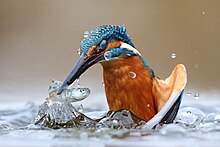Leipzig Riverside Forest




Leipzig Riverside Forest (German: Leipziger Auenwald) is one of the largest lowland Riparian forests in Central Europe, which lies mostly within the city limits of Leipzig city in Germany. The natural reserve is partially covered with hardwood forest and contains a large variety of endangered species.
Location[]

Leipzig Riverside Forest is divided into separate southern and northern parts, between which is a corridor containing many parks and green areas along the banks of the White Elster. Between the two there is a certain ecological link through a corridor that comprises parks and grassland and which lies along the , which was constructed to provide flood protection, and . The total area covered is approx. 2500 hectares. Leipzig Riverside Forest is a nature reserve.
Flora and Fauna[]
Plants[]
Originally the hardwood forest hosted more elms and black poplars which have become rare over the years, however the amount of old oaks with massive stems is still remarkable. The mixed forest contains may different tree species, almost half of them are either ash, maple or sycamore maple. Besides that you can also find small-leaved linden, common horn beam and various kinds of willows.[1] In spring the ground is covered with wild garlic, sprinkled with spring snowflakes and crested lark in colors ranging from white and pink to purple. Some rather rare plants like the Geum rivale can also be found in the wet, almost swampy parts of the area.[2]
Animals[]
The common kingfisher has become quite rare in Germany, especially due to loss of habitat. Kingfishers rely on clean floating water with a multitude of small fish and are breeding in the riverside forest. They are still considered to be endangered, so they enjoy special protection - for instance some rivers are closed-off for touristic paddeling during the breeding season.[3] In the trees one can find red squirrels and a multitude of woodpeckers such as the great spotted woodpecker as well as the black woodpecker and the European green woodpecker.[4]
Literature[]
- ENEDAS e. V./ Autorenkollektiv: Der Leipziger Auwald. Ein Natur- und Erlebnisführer. Edition Leipzig, 2013, ISBN 978-3-361-00685-0.
- Gerd K. Müller (ed.): Der Leipziger Auwald – ein verkanntes Juwel der Natur. Leipzig, 1992.
- Gerd K. Müller: Die Leipziger Auen. Staatsministerium für Umwelt und Landesentwicklung, Dresden, 1995.
References[]
- ^ "Hauptbaumarten des Leipziger Auwaldes". (in German). Retrieved 13 April 2021.
{{cite web}}: CS1 maint: url-status (link) - ^ "Wissenswertes, Pflanzen, Kräuter". (in German). Retrieved 13 April 2021.
{{cite web}}: CS1 maint: url-status (link) - ^ "Der Eisvogel". (in German). Retrieved 13 April 2021.
{{cite web}}: CS1 maint: url-status (link) - ^ "Wissenswertes, Tiere". (in German). Retrieved 13 April 2021.
{{cite web}}: CS1 maint: url-status (link)
External links[]
| Wikimedia Commons has media related to Leipziger Auenwald. |
- Leipzig Municipal Forest on the City of Leipzig website
- Auwald Leipzig – Website of Society for Environmental Education and Research
- Private website – with information about the history, extent, soil and climate of the forest
Coordinates: 51°19′02″N 12°21′24″E / 51.31719°N 12.3565364°E
- Forests and woodlands of Saxony
- Geography of Leipzig
